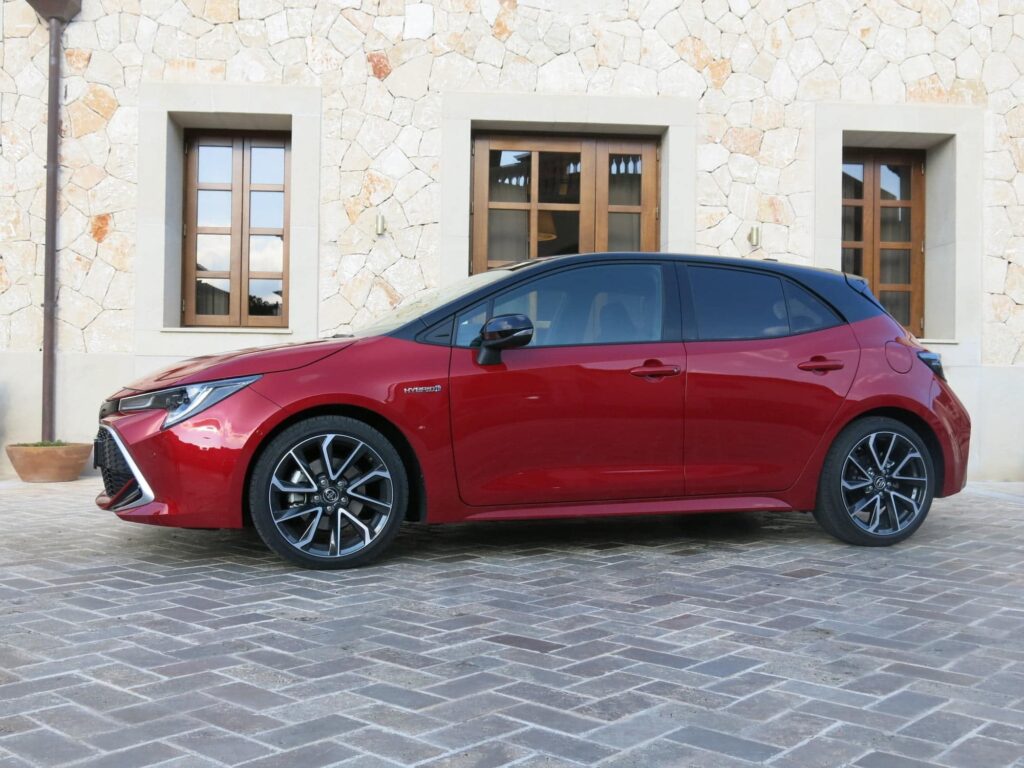The new Toyota Corolla is now here, and the Auris is just a memory.
We got to test the new Corolla on the interesting and winding roads of Mallorca.
Toyota expects the Corolla to be a sales success in Finland, and after a brief introduction, it seems that may well be the case.
While the Corolla is by no means a dazzling car, it’s not exactly colourless and bland anymore either.
The new Corolla is built on Toyota’s TNGA platform. It brings a slightly lower centre of gravity and a slightly lower driving position. In addition, Toyota says the body’s torsional rigidity has been increased by 60 percent.

One of the things that makes the car interesting is that there are three body options: Hatchback, Sedan and Sports Tourer.
Each model has its own target audience. According to Toyota, the Sedan is aimed at those who want a traditional large sedan model. The car is always powered by a 1.8-litre engine.
The Hatchback model is aimed at couples who do not yet have children or no longer have children. Three engines are available for this model: 1.2-litre, 1.8-litre and 2.0-litre.
The Sports Tourer model is, according to Toyota, aimed at families with children or those who otherwise need space. The same engines are available as for the Hatchback.
According to Toyota Finland, the biggest group of buyers will be the station wagon, the Sports Tourer. According to Toyota’s importer, the share of station wagons in Finland will be around 65%. Around 20 percent would buy the Hatchback and only 15 percent would buy the Sedan.
The smallest engine is not a hybrid, and Toyota estimates its share at only 10 %. However, it is included in the range because the importer says there is demand for it.
Toyota’s sales target in Finland is to sell 5 500 new Corollas this year.
A fourth-generation hybrid based on the 1.8-litre internal combustion engine (total power 122 hp) will be available in the range, while an all-new hybrid power line based on the 2.0-litre internal combustion engine (total power 180 hp) will be available for the hatchback and Touring Sports body styles.

More size
The Corolla’s size will increase with the model update, and the wheelbase and therefore interior space of the Touring Sports estate model, for example, will be virtually the same as that of the Toyota Avensis estate model that was discontinued last year.
The Corolla’s cabin is even slightly larger than that of the Avensis, but the boot is 28 litres smaller.
The Hachback’s wheelbase is slightly shorter than the Sedan and Sports Tourer.
There are fourtrim levels in all three body styles – Life, Active, Style and Premium.
There are slight differences between trim levels, but features such as Toyota Safety Sense and adaptive cruise control are standard across the range.
The most popular trim level across all trim levels will be Active, according to Toyota, which adds equipment such as 16-inch alloy wheels, LED headlights, a heated steering wheel, a seven-inch customisable multifunction display on the instrument panel, a media centre with an eight-inch touchscreen and a reversing camera.
Style adds 17-inch alloy wheels, Bi-led headlights and a choice of interior trim options.
At the top of the range, Premium includes, depending on the trim level, matrix-type Multi-led headlights, 18-inch alloy wheels, adaptive damping, leather upholstery (hatchback and Touring Sports) and a windscreen display.

No surprises on the road
The car is easy to drive. It goes where the driver wants it to, and the suspension is suitably stiff. It’s easy for the driver to get the driving position right, and the seats were nothing to complain about in the short test drive.
We had the chance to test both the 1.8-litre and 2.0-litre engines, both of which are good for everyday driving.
The car comes with automatic cruise control, which monitors the speed of the car in front and automatically stops the car if necessary.
In automatic mode, the acceleration of the car left something to be desired, meaning that sometimes you had to push the accelerator yourself to avoid being caught up in other traffic.
The car’s lane departure warning system generally worked well. Sometimes, however, the corrective movement was too strong. In addition, the steering was quite heavy when using the lane-keeper.
The tyre noise was not the quietest. It is not yet known how loud tyre noise sounds on Finnish roads.
In addition to tyre noise, the sound of the engine is clearly audible under hard acceleration, but it is by no means a disturbing sound.
On test drives, the hybrid Corolla’s fuel consumption dropped at best to closer to five litres per hundred kilometres.
Inside, the new Corolla gives the impression of quality. The navigation screen is in the centre of the dashboard, but the navigation system could do with a little more work.
Problems were mainly due to occasional slowness, with a few times passing a junction before the satnav caught up.

For whom?
Toyota itself has defined its target audience for the different versions of the Corolla. In Finland, the estate model will be the main focus and you can well imagine that existing Toyota customers will be happy to upgrade their Auris and also their Avensis to the new Corolla.
The Corolla will probably become the number one product in Toyota’s range, and the estate model in particular will attract new customers from competitors.
In addition, the Corolla will certainly become an important option in the company car market.
The cheapest versions of the Corolla are the Hatchback and Sports Tourer models with a 1.2-litre engine. They cost €22,994.
The cheapest model of the sedan costs €26 994. The Sedan model always has a 1.8-litre engine.
The Sports Tourer with a 1.8-litre engine costs €27 498 and €31 566 with a two-litre engine.













